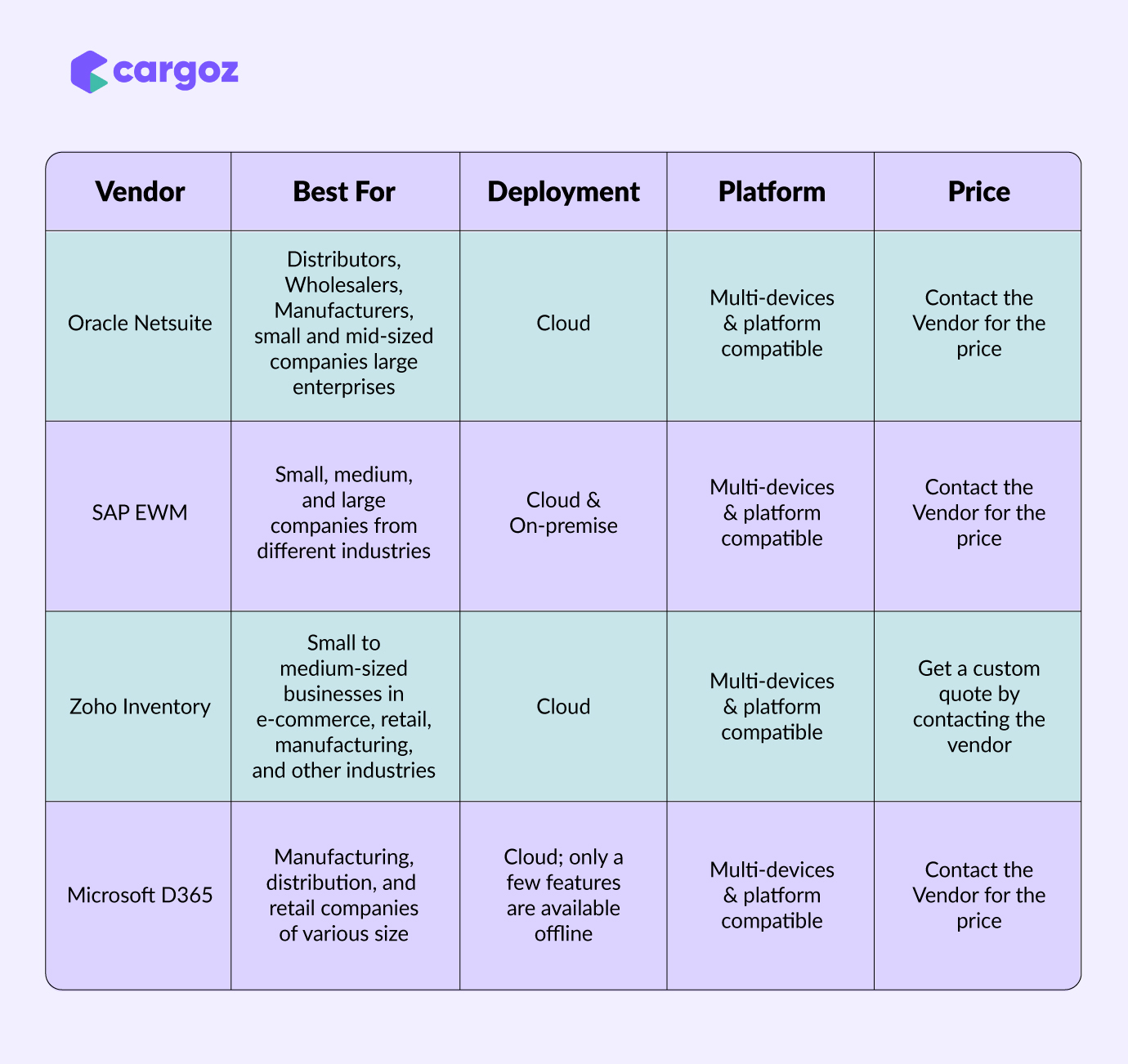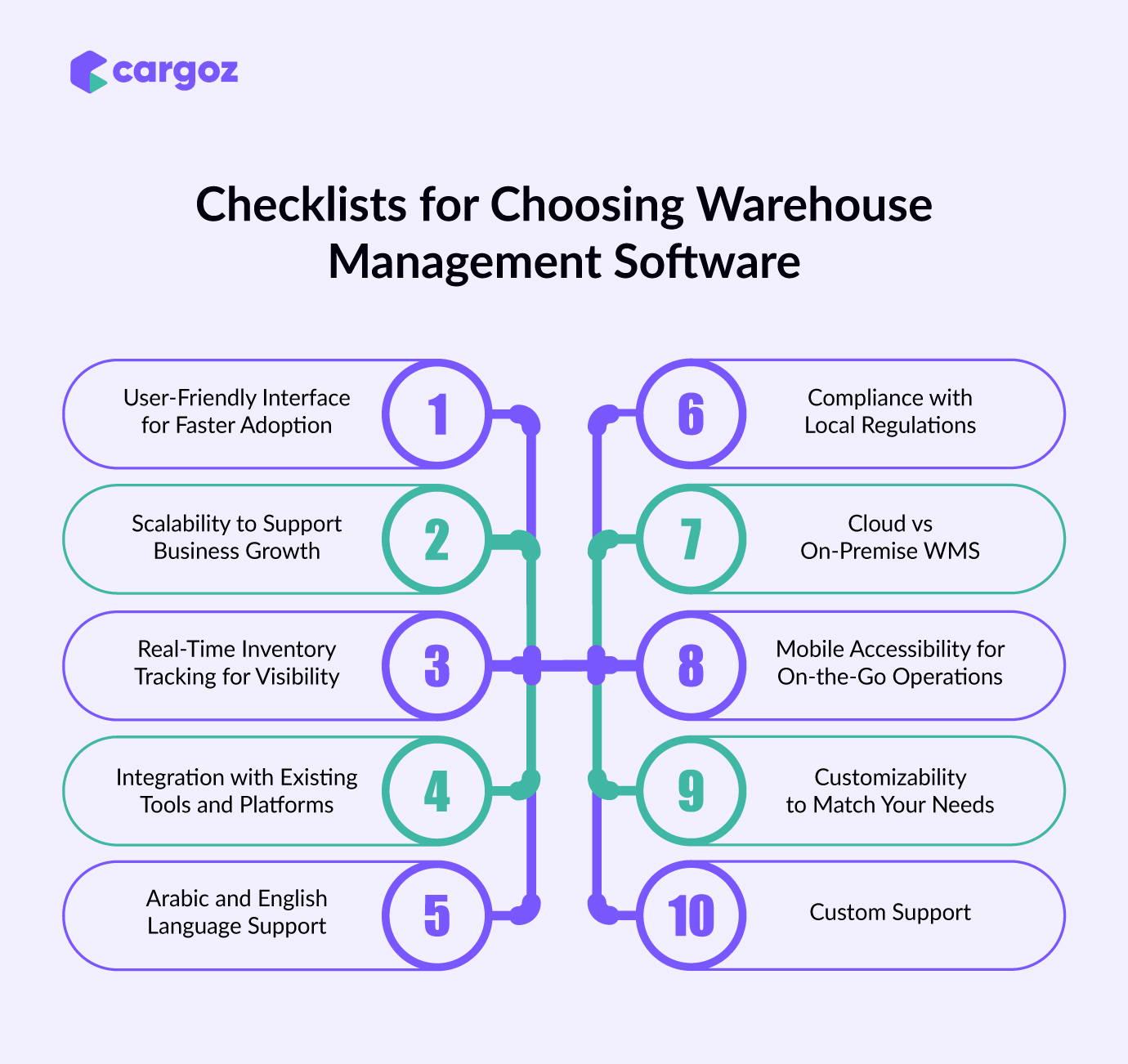Lost sales, operational inefficiency, inaccurate reporting, and more; these are some of the problems businesses may face without an efficient warehouse management system.
As competition intensifies, integrating warehouse management software (WMS) has become increasingly essential for small businesses, as it enables real-time tracking and advanced analytics. As a result, more companies are adopting these solutions in their businesses.
According to a Market and Market report, the global WMS market is projected to grow from USD 4 billion in 2024 to USD 8.6 billion in 2029, growing at a CAGR of 16.3%. But so many options, how do you choose the right one for small businesses in the Middle East?
In this blog, we will explore the top four solutions for small businesses and the key factors to consider when selecting the best one for your business.
What are the Top Warehouse Management Software for Small Businesses in the UAE?
There are many warehouse management software available, but not all of them offer the right features. Here are our top four picks.
Oracle NetSuite
Key Features:
1. Mobile receiving and defined putaway strategies to ensure that items are stored in a way that best utilises warehouse space.
2. Wave release and intelligent pick-and-pack strategies for both single- and multi-order picking.
3. Mobile warehouse management to manage receiving, putaway, picking, and packing directly from a mobile device.
4. Mobile picking functionality to reduce the overhead of managing bins across warehouse locations.
5. Cycle counting solution to automate inventory counts without freezing transactions in the entire location
Benefits:
1. Real-time tracking of inventory movement and stock levels
2. Accurate capturing of item, lot and serial numbers as goods are received
3. Optimized space utilization in warehouses
4. Increased labour productivity using mobile warehouse management
5. Higher customer satisfaction with improved order fill rates and accuracy
SAP Extended Warehouse Management (EWM)
Key Features:
1. Inbound processing and management: receiving, preparation and putaway planning, storage, and loading
2. Direct storage and internal processing: labour management, kit-to-stock, kit-to-order, repackaging, labelling, and more
3. Outbound warehouse processes: wave planning, RF and voice-based picking, packing and staging, loading, etc.
4. Built-in material flow system technology, warehouse analytics and monitoring
Benefits:
1. Optimization of warehouse operating costs, including inventory and labour
2. Enhanced customer service with better flexibility and scalability
3. Improved productivity and accuracy
4. Transparency across stock, processes, labour, and warehouse automation
5. Enhanced compliance for international trade and sustainability
6. Make your warehouse more risk-resilient and flexible
Zoho Inventory
Key Features:
1. Manage multiple warehouses at multiple locations, dispatch and track orders, and generate reports
2. Inventory control features to monitor stock levels, track product expiries, and determine reorder points from chosen suppliers
3. Multi-channel selling and trading in multiple currencies
4. Auto-generated packing slips, shipping labels, real-time rates, and post-shipment updates to support the order fulfilment process
5. Generate purchase and sales reports to get insights on products, payments, customers and stock details to make well-informed decisions
Benefits:
1. First In, First Out (FIFO) tracking to value stock and automatically clear old stock
2. Common dashboard to view sales orders and orders that are invoiced, pending, packaged, and delivered
3. Set up customer accounts and integrate them with payment accounts to facilitate online payments
4. Manage transportation costs by dispatching orders from the nearest warehouse
5. Serial number tracking (label items in inventory) to manage inventory from purchase to sale
Microsoft D365 Supply Chain Management
Key Features:
1. Automated warehouse management processes and intelligent fulfilment
2. Planning, forecasting, and stock management features to eliminate stockouts and optimize stock placement
3. Insights and automation to streamline procurement and sourcing
4. Manufacturing and shop floor management features to enhance the visibility of the production floor and simplify production accounting
5. Intelligent order management and centralized pricing with real-time data
6. Proactive or predictive asset management and equipment maintenance
Benefits:
1. Streamline warehouse operations, improve service levels, and ensure maximum on-time and in full deliveries
2. Improve shop-floor efficiency and unify data to create intelligent warehousing and manufacturing processes
3. Optimize asset utilization and increase overall equipment effectiveness
4. Reduce ramp-up time for new workers and minimize travel time within the warehouse
5. Meet growing e-commerce needs with a resilient and predictive supply chain
Warehouse Management Software Comparison Table

What Are the Factors to Consider When Selecting Warehouse Management Software in Dubai?

Warehouse management software is essential for handling your inventory in real-time, but selecting the right one is crucial. Here are the key factors to consider when selecting a warehouse inventory management software.
1. User-Friendly Interface for Faster Adoption
A clean, intuitive interface ensures that even non-technical users can use the software and complete tasks quickly. This is particularly important in small businesses, where warehouse staff often manage multiple tasks simultaneously and can’t afford to spend days in training. A user-friendly WMS helps your team:
- Navigate workflows with minimal training
- Focus more on operations and less on troubleshooting
- Reduce data entry errors
2. Scalability to Support Business Growth
As your business expands to new locations or you adopt flexible models like on-demand warehousing, your software should be capable of scaling to meet increasing operational demands. Scalable WMS platforms allow you to:
- Add more users or storage locations
- Manage increased SKU volumes
- Upgrade features without switching systems
For example, a warehouse handling 500 SKUs today might need to manage 5,000 in a year—your WMS should handle this without slowing down or increasing complexity disproportionately.
3. Real-Time Inventory Tracking for Visibility
Real-time tracking is crucial for efficient inventory management for small businesses, helping them prevent stockouts, avoid overstocking, and meet customer expectations. It reduces human error and provides accurate insights for demand planning.
According to an Omniful report, real-time inventory systems can reduce operational costs by up to 30%.
4. Integration with Existing Tools and Platforms <H3>
Data is critical for every business, and your WMS should easily integrate with other digital tools you already use for seamless data exchange. This ensures the automated and efficient flow of data across departments, minimising manual intervention. Common integrations include:
- ERP systems (e.g., Odoo, SAP)
- Accounting tools (e.g., Tally, Zoho Books)
- eCommerce platforms (e.g., Amazon, Shopify)
- Shipping/logistics tools (e.g., Aramex, FedEx)
5. Arabic and English Language Support
If you are operating in the UAE, Saudi Arabia, or anywhere across the GCC, don't you need a bilingual WMS that offers support in Arabic and English?
A bilingual support ensures your local warehouse teams can work comfortably in Arabic, while your overseas partners will rely on English. More importantly, it helps you adhere to the local invoicing and reporting regulations, so you can be ready for audits or inspections.
6. Compliance with Local Regulations
Your WMS should comply with the local regulations, including VAT handling in the UAE and Saudi Arabia, local warehousing norms, and customs reporting for cross-border shipments. The software should be capable of generating compliant invoices, maintaining audit trails, and preparing reports for government agencies. Look for software that:
- Handles tax calculations (including GCC VAT)
- Maintains transaction audit trails
- Supports government reporting formats
- Includes region-specific modules when available
7. Cloud vs On-Premise WMS
Choosing between cloud and on-premise depends on your IT infrastructure and business needs:
- Cloud-based WMS: Ideal for SMEs, lower upfront cost, remote access, automatic updates
- On-premise WMS: Greater control over data, suited for businesses with strict compliance needs
In the Middle East, cloud adoption is accelerating, but regulated sectors may prefer hybrid setups.
8. Mobile Accessibility for On-the-Go Operations
Mobile accessibility is essential for warehousing and logistics businesses as it allows you to perform various tasks on the go. A WMS that offers full functionality via smartphones or tablets allows warehouse staff to update inventory, scan barcodes, and complete tasks on the move. According to an ARC advisory report, businesses that implemented mobile warehouse management systems improved productivity by up to 25% and reduced labour costs by approximately 30%.
9. Customizability to Match Your Needs
Every business is unique, so a customizable WMS workflow is essential to meet your specific business needs. Your WMS should be able to set user roles, adjust notification settings, and create custom reports tailored to your business demands. Here is how a customised WMS helps:
- Real-time Data: Get instant visibility into inventory, orders, and warehouse operations for faster, smarter decisions.
- Tailored Reporting: Create custom reports that track the key metrics most important to your business.
- Specific KPI Tracking: Monitor key performance indicators, such as order accuracy and cycle time, to stay on target.
- Demand Forecasting: Use predictive analytics to forecast demand and optimise stock levels, reducing waste and overstocking.
10. Custom Support
Why is customer support so important when looking for a WMS?
With digitisation, your warehouse operations depend on WMS, and strong customer support ensures the software remains in working condition. When working in the UAE, partnering with a provider who understands local business norms and speaks your language can reduce downtime, expedite issue resolution, and ensure smoother day-to-day operations.
Look for vendors who offer:
- Hands-on onboarding and training
- Multilingual customer service
- Ongoing system updates and prompt issue resolution
Final Words
The warehouse management system is crucial for efficiently managing warehouse operations. However, making the right choice is essential to ensure it addresses your business needs.
At Cargoz, we're happy to help you select the right WMS tailored to your specific business needs. We can discuss your current warehouse needs and show how we can help you enhance your warehousing operations.
Share your details here or give us a call at 800 66 55 44, and will be happy to assist you.
Frequently Asked Questions
1. How does a warehouse management system help reduce operational costs for SMEs?
WMS reduces costs by optimising storage space, reducing stockouts and overstocks, minimising manual errors, and expediting order fulfillment. Small businesses can save time, reduce labour costs, and avoid costly inventory mistakes.
2. Can small businesses start with a basic system?
Yes, small businesses can start with a basic or modular WMS that offers essential features like inventory tracking and order management. Many providers offer scalable plans, making it easier to increase capabilities and add new features as the business grows.
3. Which WMS is best suited for the logistics challenges in the Middle East?
The right fit depends on your business size, product type, and shipping needs, Arabic language compatibility, and integration with your existing systems.
4. Can WMS integrate with e-commerce platforms used in the UAE or GCC?
Yes, most WMS platforms integrate easily with e-commerce platforms such as Shopify, WooCommerce, and Amazon. This ensures seamless order processing, financial tracking, and inventory updates.
5. How much does warehouse management software typically cost for small businesses?
The cost can vary depending on the features, your business size, and the WMS provider you choose. Some platforms offer a pay-as-you-grow model, which is ideal for startups or small businesses.